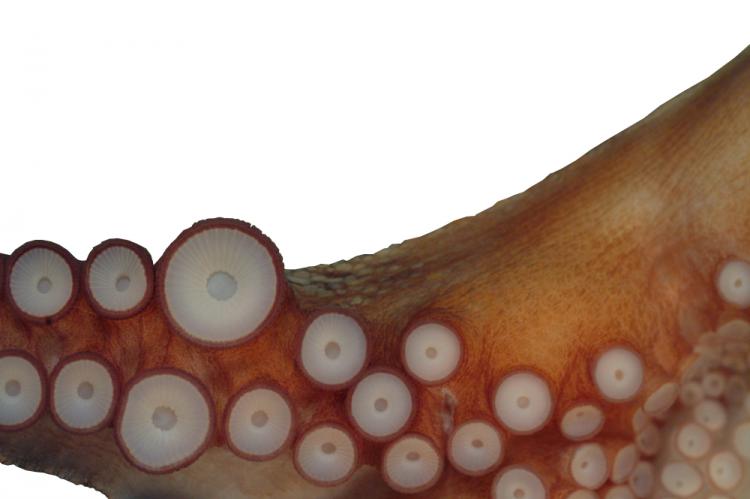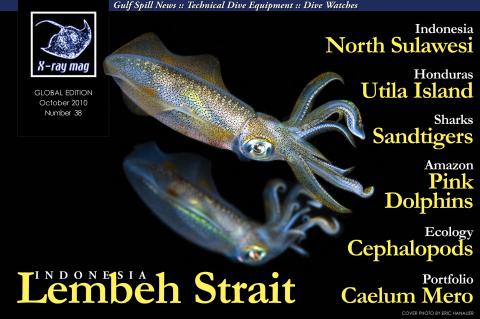Cephalopods - Jet-powered Masters of Disguise
Most cephalopods—the group in which scientists classify octopuses, squid, cuttlefish and nautiluses—can change color faster than a chameleon. They can also change texture and body shape, and if those camouflage techniques don’t work, they can still “disappear” in a cloud of ink, which they use as a smoke-screen or decoy.
Cephalopods are also fascinating because they have three hearts that pump blue blood; they’re jet powered; and they’re found in all the oceans of the world—from the tropics to the poles, from the intertidal to the abyss.
Tags & Taxonomy
Cephalopods have inspired legends and stories throughout history and are thought to be the most intelligent of the invertebrates. Some can squeeze through the tiniest of cracks. They have eyes and other senses that rival those of humans.
Brainy
The class Cephalopoda, which means “head foot”, are mollusks and therefore related to bivalves (scallops, oysters, clams), gastropods (snails and slugs), scaphopoda (tusk shells), and polyplacophorans (chitons). Some mollusks, such as bivalves, don’t even have a head, much less something large enough to be called a brain! Yet, cephalopods have well-developed senses and large brains. Most mollusks are protected by a hard external shell and many of them are not very mobile. Although the nautilus has an external shell, the trend in cephalopods is to internalize and reduce the shell. The shell in cuttlefish, when present, is internal and is called the cuttlebone, which is sold in many pet shops to supply calcium to birds. Squid also have a reduced internal shell called a pen. Octopuses lack a shell altogether.
Cephalopods are found in all of the world’s oceans, from the warm water of the tropics to the near freezing water at the poles. They are found from the wave swept intertidal region to the dark, cold abyss. All species are marine, and with a few exceptions, they do not tolerate even brackish water.
Ancient
Cephalopods are an ancient group that appeared some time in the late Cambrian period several million years before the first primitive fish began swimming in the ocean. Scientists believe that the ancestors of modern cephalopods (Subclass Coleoidea: octopus, squid, and cuttlefish) diverged from the primitive externally-shelled Nautiloidea (Nautilus) very early—perhaps in the Ordovician, some 438 million years ago.
How long ago was this? To put this into perspective, this is before the first mammals appeared, before vertebrates invaded land and even before there were fish in the ocean and upright plants on land! Thus, nautilus is very different from modern cephalopods in terms of morphology and life history.
Cephalopods were once one of the dominant life forms in the world’s oceans. Today, there are only about 800 living species of cephalopods. By comparison, there is 30,000 living species of bony fish. However, in terms of productivity, some scientists believe that cephalopods are still giving fish a run for their money.
Many species of cephalopods to grow very fast, reproduce over a short period of time, and then die. With over-fishing and climate change, there may be more biomass of cephalopods now than anytime in recent history.
Color change
Cephalopods use their awesome abilities to change their color and appearance primarily for two things: camouflage and communication. The ability of the cephalopods to change color is a trait that has evolved over time due to a greater need to avoid predators and become competitive in an environment shared with vertebrates.
These abilities, and the behaviors associated with them, have become a major contributing factor to the success of the cephalopod family and are great examples of adaptation—physically, through natural selection, and behaviorally.
Camouflage
Camouflage is usually a cephalopod’s primary defense against predators. As cephalopods don’t have the protection of hard shells like many of their mollusk relatives, they make an easy to digest meal for a hungry predator. Therefore, most cephalopods try to avoid being seen to avoid being eaten. As well as predator avoidance, camouflage can also be used when lying in wait for unsuspecting prey to pass. Interestingly, cephalopods have more than one strategy for camouflage, and these will be discussed here.
Resembling the background
Background resemblance is the most well known form of camouflage. This is when the animal changes its color and texture to match as closely as possible that of its background. Cephalopods use their chromatophores to change color to match the brightness of the environment they are attempting to blend into, and some can also change texture using muscles in their skin. Many also use different body postures to help with this. They may hold their arms in certain ways or flatten them on the substrate to become what appears to be simply part of the scenery.
Deceptive resemblance
As well as simply trying to blend into a background, some cephalopods will attempt to make themselves appear like a specific object in their environments. This is termed deceptive resemblance.
The Caribbean reef squid, Sepioteuthis sepioidea, is often seen floating vertically at the surface of the water with its arms pointing downward to resemble floating sargassum weed. Some octopus may curl all their arms up into a ball, and add texture to their skin to appear like a rock.
Octopus cyanea has also been seen swimming in a manner that makes it appear like a reef fish by swimming with all its arms together and creating false eye spots. ...
(...)
Download the full article ⬇︎

Originally published
X-Ray Mag #38
Indonesia - North Sulawesi | Honduras - Utila Island | Sharks - Sandtigers | Amazon - Pink Dolphins | Ecology - Cephalopods | Portfolio - Caelum Mero



